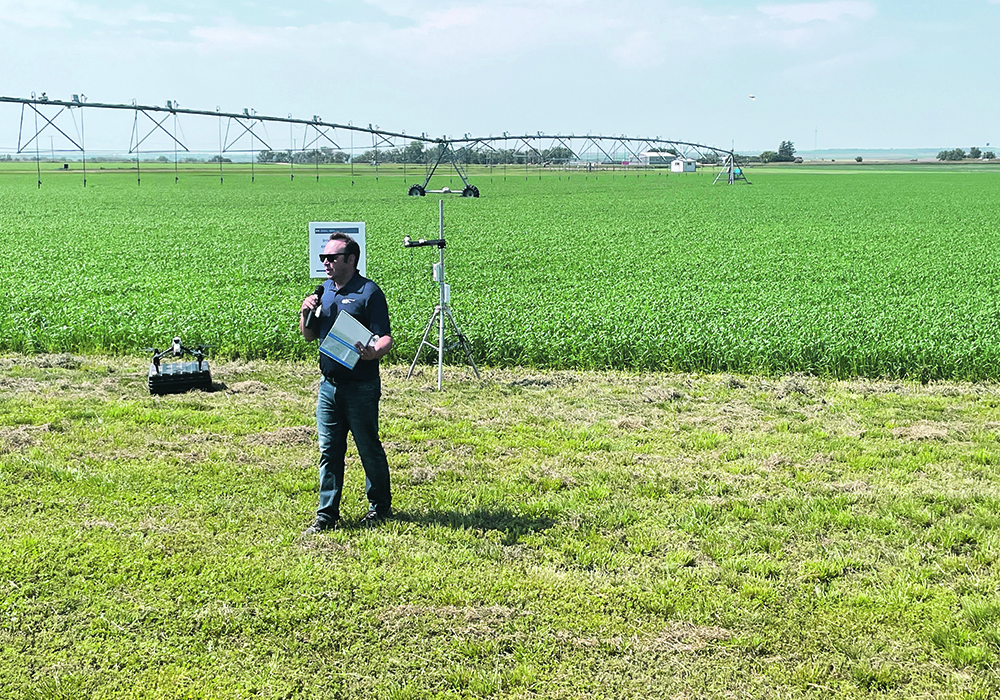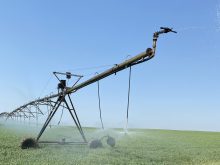Research in Saskatchewan has found that using multispectral and thermal data can eliminate user input and save time
Variable rate systems are commonly associated with seeding or fertilizer application, but it’s also used in the world of irrigation.
Those attending the Outlook Irrigation Field Day held last month near Outlook, Sask., heard about recent advancements with variable rate irrigation (VRI) systems that can lead to a more economical and sustainable use of water and irrigation.
“The work that we’re doing out here is focusing in on the irrigation technology to improve water use efficiency and water productivity,” said Evan Derdall, a specialist in irrigation technology from Agriculture Canada.
Read Also

Trump’s tariffs take their toll on U.S. producers
U.S. farmers say Trump’s tariffs have been devastating for growers in that country.
“With Lake Diefenbaker and the water that we utilize for irrigation, it is a public resource. So, we want to make sure that we’re using it to the best of our abilities and maximizing productivity for every drop we’re putting on our fields.”
VRI is comparable to variable rate fertilizer and seeding, allowing a producer to program and control the irrigation sprinklers for efficiency and smart water use. It allows for correct water application throughout the field, maximizing the water available to the producer by limiting any under- and over-watering.
Derdall said VRI improves water use efficiency by 15 to 16 per cent compared to traditional centre pivots because it eliminates constant water application rates on an entire field. While the percentage of improvement will vary by field, producers who experience irregularity in soil texture or those with varying landscapes would see the largest benefits.
However, VRI requires a lot of user input and a significant time commitment when it comes to entering data and surveying fields.
“One of the biggest issues with the VRI system is that they require user input, so it requires me (as a producer) to put in a map, specify where I want it, all the water, how much, etcetera. And that gets pretty time consuming,” Derdall said.
“Even if you have some remote monitoring, it’s pretty time consuming and labour intensive. And usually, farmers, one of the last things they have is time.”
He said an accelerating system that uses satellite technology can reduce much of the user input. A device that looks a bit like a camera is installed on the top of the pivot, at its centre. It scans the land ahead of the pivot as it moves around the field to collect multispectral and thermal data.

Multispectral data is captured as an image of light wavelengths from the scanned area. The light wavelengths of plants vary depending on their health, shown through water content and cell structure, which can’t be seen by the human eye.
Thermal data comes from sensors that detect the temperature of canopy and surrounding air. Air temperatures vary with water application throughout the growing season, and the sensors can monitor this and provide a better idea as to when and where to apply water.
These two types of data are fed to a receptor point, which the system uses for machine learning.
“So, as it’s going around, it’s using that collected data and the in-field soil moisture monitor to try to match and develop these variable rate prescriptions on the fly. Every time it goes around the field to apply, it’s learning, and it’s going to try to vary that application rate to try the best match what the crop needs.”
The machine-learning system is satellite based, Derdall said, and the technology continues to improve.
“There has been advances in thermal technology mounted on some of the more recent satellite constellation missions, and we can utilize what we’re learning here in the field, apply it to that kind of large scale and hopefully develop tools that can help producers’ irrigation schedule from their phone.”
The Prairie Irrigation Scheduling manual includes information about the latest systems and management, including the newer Saskatchewan-based information.
















